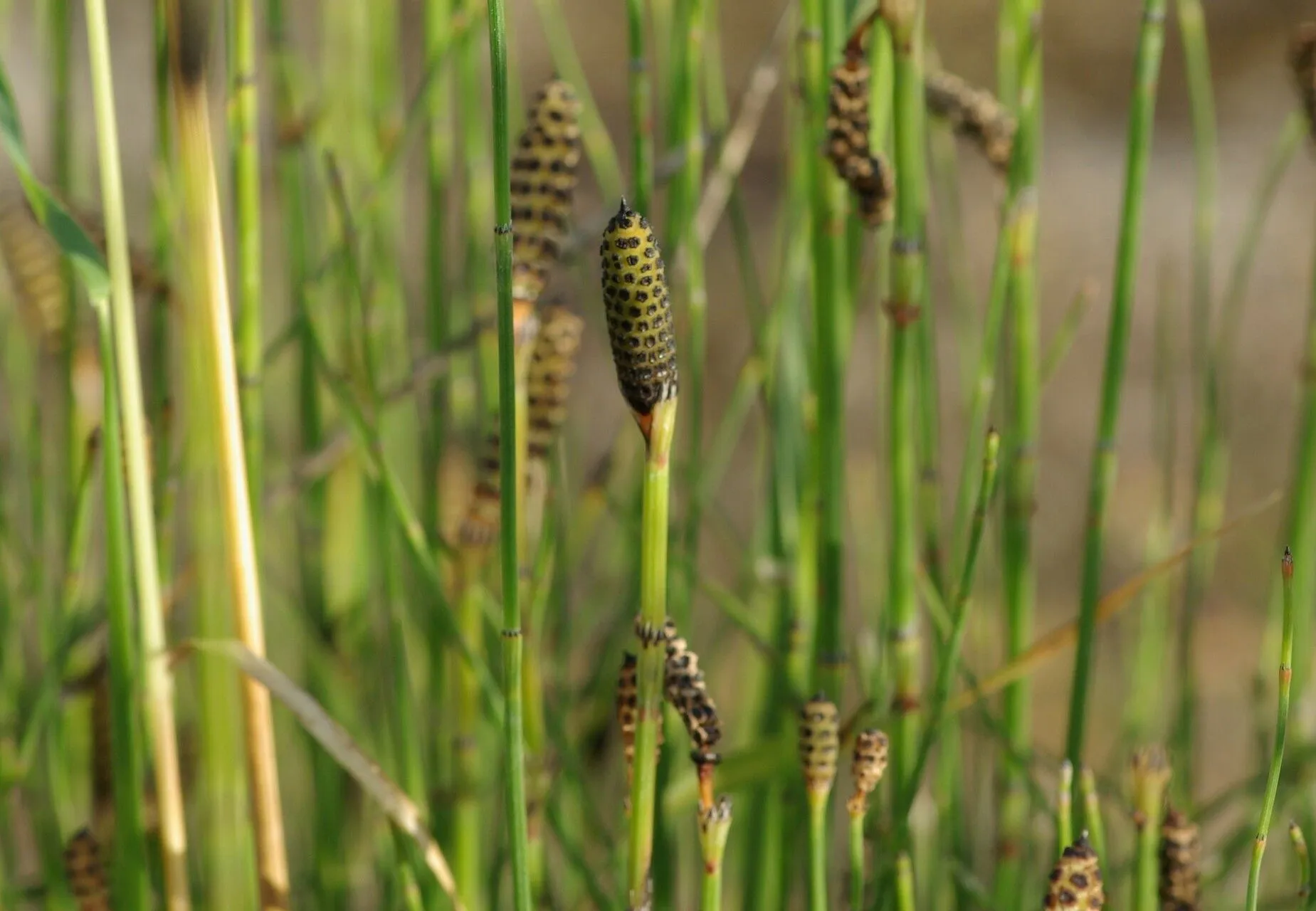
Author: Desf.
Bibliography: Fl. Atlant. 2: 398 (1799)
Year: 1799
Status: accepted
Rank: species
Genus: Equisetum
Vegetable: Unknown
Observations: Temp. & Subtrop. Old World, Ethiopia to S. Africa
Branched horsetail, known scientifically as Equisetum ramosissimum, is a remarkable plant distinguished by its unique, segmented stems and distinctive growth pattern. Described thoroughly in Fl. Atlant. in 1799 by the renowned botanist Desfontaines, this species is an intriguing member of the Equisetaceae family.
This perennial plant is noted for its extensive branching, which sets it apart from other members of the horsetail family. Its botanical architecture features jointed stems that are characterized by their hollow, straw-like appearance, making them somewhat reminiscent of bamboo, albeit much finer and smaller. Each section, or internode, is punctuated by small whorls of tiny, scale-like leaves which fuse into a sheath around the stem.
Branched horsetail thrives predominantly in temperate and subtropical regions across the Old World. Its presence stretches from Ethiopia down to South Africa, underscoring its adaptability to diverse climates within this broad geographical range. This distribution indicates the plant’s versatile nature, allowing it to establish itself in varied ecological settings, from moisture-rich environments to drier, well-drained soils.
Historically, species of the horsetail family, including Equisetum ramosissimum, have been valued for their abrasive silica content, traditionally used in polishing fine metals and wood. While the branched horsetail continues to grow in loamy soils and alongside wetlands, its importance is appreciated in both its ecological role and its aesthetic contribution to botanical collections and natural landscapes.
The branched horsetail’s scientific significance extends beyond its unique form and utility. As an ancient lineage of plants, its existence also offers valuable insights into the evolutionary history of plant life on Earth, portraying how certain structures and growth habits have stood the test of time.
Eng: branched horsetail, boston horsetail, branched scouringrush
Dan: gren-padderok
Fra: prêle très rameuse, prêle ramifiée
Nld: vertakte paardenstaart
Deu: ästiger schachtelhalm, žstiger schachtelhalm
Ita: equiseto ramosissimo
Cym: marchrawn canghennog, marchrawnen ganghennog
En: Branched horsetail, Boston horsetail, Branched scouringrush
Ca: Cua de cavall ramosa, Trencanua
Da: Gren-padderok
Nl: Vertakte paardenstaart, Vertakte Paardestaart
Fr: Prêle très rameuse, Prêle ramifiée, Prêle très ramifiée, Prêle rameuse, Prêle, Herbe sans feuille
De: Ästiger Schachtelhalm, Žstiger Schachtelhalm, Sand-Schachtelhalm
He: שבטבט ענף
It: Equiseto ramosissimo
Es: Equiseto ramoso
Cy: Marchrawn Canghennog, Marchrawnen Ganghennog
Taken Jul 5, 2022 by Boumlik Messaïli (cc-by-sa)
Taken Aug 14, 2017 by Tela Botanica − Sylvain PIRY (cc-by-sa)
Taken Apr 10, 2013 by Tela Botanica − Marie-Hélène LA LUMIA (cc-by-sa)
Taken Aug 30, 2018 by Manuel Nieto (cc-by-sa)
Taken May 16, 2011 by Miguel A. C. (cc-by-sa)
Taken Jul 4, 2015 by Tela Botanica − Bernard SUDAN (cc-by-sa)
Taken Apr 10, 2013 by Tela Botanica − Marie-Hélène LA LUMIA (cc-by-sa)
Taken Aug 8, 2019 by clement cognet (cc-by-sa)
Taken Aug 30, 2018 by Manuel Nieto (cc-by-sa)
Taken May 16, 2011 by Miguel A. C. (cc-by-sa)
Taken Oct 22, 2019 by anouk daguin (cc-by-sa)
Taken Nov 12, 2020 by Otero Antoni (cc-by-sa)
Taken Jul 25, 2021 by Fondo Natural asociación (cc-by-sa)
Taken Sep 30, 2022 by F. Manzano (cc-by-sa)
Taken Nov 14, 2021 by Giovanni Vannacci (cc-by-sa)
Taken Jul 25, 2021 by Fondo Natural asociación (cc-by-sa)
Taken May 5, 2014 by Tela Botanica − Daniel CAHEN (cc-by-sa)
Taken May 20, 2014 by Tela Botanica − Marie PORTAS (cc-by-sa)
Taken Dec 10, 2016 by João Pedro João Pedro (cc-by-sa)
Taken Nov 14, 2021 by Giovanni Vannacci (cc-by-sa)
© copyright of the Board of Trustees of the Royal Botanic Gardens, Kew.
Taken Jul 20, 2017 by Tela Botanica − Liliane ROUBAUDI (cc-by-sa)
Taken Jul 20, 2017 by Tela Botanica − Liliane ROUBAUDI (cc-by-sa)
Taken Jul 20, 2017 by Tela Botanica − Liliane ROUBAUDI (cc-by-sa)
Taken Aug 14, 2017 by Tela Botanica − Sylvain PIRY (cc-by-sa)
Taken Apr 12, 2016 by Tela Botanica − Jean-Marie PAGNIER (cc-by-sa)
Taken Apr 15, 2012 by Photoflora – Benoit BOCK (©)
Taken Jan 4, 2014 by Tela Botanica − Liliane Roubaudi (cc-by-sa)
Taken Jan 4, 2014 by Tela Botanica − Liliane Roubaudi (cc-by-sa)
Taken Jun 9, 2022 by Álvarez Machuca (cc-by-sa)
Taken Apr 26, 2016 by Tela Botanica − Genevieve BOTTI (cc-by-sa)
Family: Myrtaceae Author: (F.Muell.) K.D.Hill & L.A.S.Johnson Bibliography: Telopea 6: 402 (1995) Year: 1995 Status:…
Family: Rubiaceae Author: Pierre ex A.Froehner Bibliography: Notizbl. Bot. Gart. Berlin-Dahlem 1: 237 (1897) Year:…
Family: Sapindaceae Author: Koidz. Bibliography: J. Coll. Sci. Imp. Univ. Tokyo 32(1): 38 (1911) Year:…
Family: Asteraceae Author: A.Gray Bibliography: Pacif. Railr. Rep.: 107 (1857) Year: 1857 Status: accepted Rank:…
Family: Fabaceae Author: Medik. Bibliography: Vorles. Churpfälz. Phys.-Ökon. Ges. 2: 398 (1787) Year: 1787 Status:…
Family: Aspleniaceae Author: (Cav.) Alston Bibliography: Bull. Misc. Inform. Kew 1932: 309 (1932) Year: 1932…